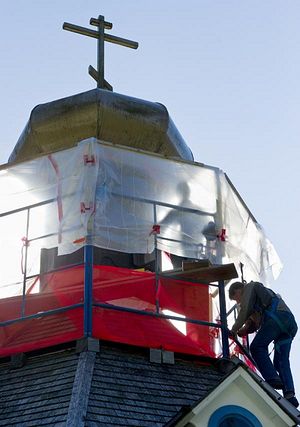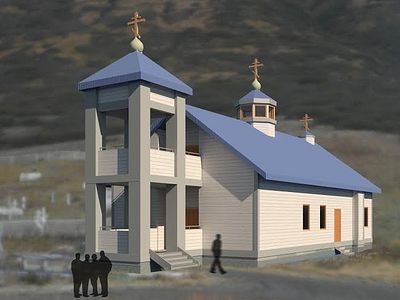More than 100 years ago, oral tradition goes, several Tlingit leaders in Juneau were having a recurring dream. In it, a short man with a white beard told them they should become Christian.
“When the men saw an icon of St. Nicholas the Wonderworker, Archbishop of Myra in Lysia, they all recognized him as being the man in their dreams,” says a written oral history on the website of Juneau’s St. Nicholas Russian Orthodox Church.
One of those men and his wife were baptized, inspiring around 700 other Tlingit people to do the same. Shortly after, it was Tlingit residents of Juneau who spearheaded the establishment of a Russian Orthodox Church in town. It’s the only story like that he knows, said Rt. Rev. David, Bishop of Sitka and Alaska.
(The bishop’s last name is Mahaffey, but bishops are monastic, and, as a monk, he’s given up his last name.)
In recent years, some of the many Russian Orthodox Churches around Alaska have fallen into disrepair, and St. Nicholas is getting fixed up and restored to something more like its former glory.
The National Park Service is working closely on the restoration with ROSSIA, or Russian Orthodox Sacred Sites in Alaska, an Anchorage-based nonprofit founded by a previous bishop, said Rev. David. ROSSIA got a state grant for this project.
“(The previous bishop) recognized that throughout Alaska, we’re losing this Russian architecture,” Rev. David said.
Working on a historical structure like the church offers particular challenges, said Alaska Commercial Contractors co-owner Jason Murdoch.
In some of the work, they have to use old tools to get the work done, he said.
“We had to build a very large miter box (guide for the saw)… they don’t have powered miter saws that are available now for small projects like this,” he said. “And the location’s difficult… everything’s off a scaffold.”
They began this part of the project in April, and the majority of the work has taken place this summer.
“Over the years there had been some added layers to the woodwork below the onion dome, and it wasn’t historic wood,” Murdoch said. “It was layers of shingles and stuff. We removed all that and are bringing it back to its original construction.”
They also removed rot, are applying new steel scallops, and are currently working on the drum (the vertical portion) of the dome. They plan to be finished by the end of the month.
Last summer, Alaska Commercial Contractors installed a new foundation, Murdoch said. Before that, they put the bell tower structure back up and re-roofed the rectory.
The church roof was repaired in 2007, said National Park Service senior historical architect Grant Crosby.
“You’ve got eight sides to the building, so it’s a great opportunity for leaks to happen,” Crosby said. “Perhaps the most important thing people can have in Juneau is a good roof. And gutters.”
“It doesn’t leak when it rains anymore,” said Father Paul Erickson of Juneau’s local congregation. “That’s the main big one.”
In the future, they’re talking about re-gilding the dome, Crosby said, and plan to rehabilitate the rectory, restoring its exterior to its original appearance. It’s been changed over the years, in part by the location of the sidewalk.
Some of the boards that have been removed show “shadows” — ghostly imprints — of what once was there, said Anne E. Matsov, a historical architect with the National Park Service.
A chronic shortage of money is both the friend and enemy of historic preservation, said Crosby. It means they don’t always have the money to do the repairs that are needed, but it also means that when repairs were done in the past, it was frequently in a way that left residual material, giving modern-day historical architects a better idea of what different structures once looked like. That’s the case with some of the features of the onion dome.
Re-gilding it will help it look more like what it symbolizes: the onion dome represents the flame of the Holy Spirit and Pentecost, the bishop said.
Saint Nicholas is unique in another way besides its founding story — it’s the only octagonal church out of more than 90 in Alaska.
Russian Orthodox churches have three traditional shapes, Bishop David said: a cross, symbolizing resurrection; a circle, symbolizing the eternity of the church; and a rectangle, symbolizing the church as a ship. He theorizes that an octagon was just as close as 19th century builders in Juneau could get to a circle.
ROSSIA received grant funding for the project from the state; that grant was matched by the Rasmuson Foundation. Not including donated time and energy, the project cashes in at $37,915, Matsov said.
Cumulatively, Crosby said, investment from a variety of different sources is inching towards half a million dollars.
Other Russian Orthodox churches in Southeast Alaska are in downtown Sitka, and in Angoon and Hoonah. The bishop hasn’t yet visited those in Angoon or Hoonah, but said they’re both probably badly in need of repair.
The Sitka church was founded in 1846, Mahaffey said; Juneau’s church was founded in 1894.
“This is very exciting to see this come to fruition,” Crosby said of St. Nicholas’ ongoing repairs. “We’ve been talking about it for a long time… It’s really returning some of the architectural detail of the church that’s been stripped away over the years.”
“These structures are the history of Alaska,” Bishop David said.
• Contact Capital City Weekly staff writer Mary Catharine Martin at maryc.martin@capweek.com.



